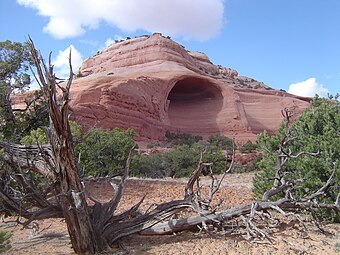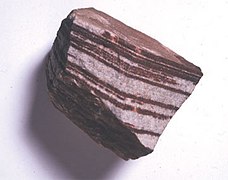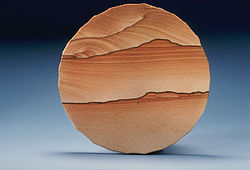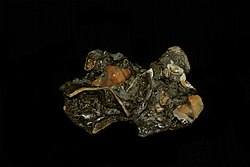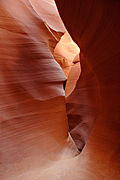Пешчар — разлика између измена
. ознака: везе до вишезначних одредница |
|||
| Ред 1: | Ред 1: | ||
{{Short description|Type of sedimentary rock}}{{rut}} |
|||
'''Пешчар''' ({{ијек|пјешчар}}) или '''пешчењак''' ({{ијек|пјешчењак}}) ({{јез-енгл|Sandstone}}, {{јез-фр|Grès}}, {{јез-нем|Sandstein}}, {{јез-рус|Песчаник}}), је везана [[Седиментне стене|седиментна стена]] (везани седимент) изграђена претежно од кластичних зрна величине 2–0,05 [[милиметар|mm]]<ref>Геолошка терминологија и номенклатура IV петрологија, Београд, 1975</ref>. Према крупноћи везаних зрна (гранула) спада у [[псамит]]е. |
|||
У погледу минералног састава пешчари су обично изграђени доминантно од зрна [[кварц]]а, љуспица [[мусковит]]а и [[фелдспат]]а, а потом и [[циркон]]а, [[апатит]]а, [[магнетит]]а, [[гранат]]а, [[турмалин]]а. Везиво може бити калцијумкарбонатно (вапновито), лапоровито, глиновито, доломитско, силицијско, гвожђевито(лимонит), битуминозно (органског порекла) и др. |
'''Пешчар''' ({{ијек|пјешчар}}) или '''пешчењак''' ({{ијек|пјешчењак}}) ({{јез-енгл|Sandstone}}, {{јез-фр|Grès}}, {{јез-нем|Sandstein}}, {{јез-рус|Песчаник}}) везана je [[Седиментне стене|седиментна стена]] (везани седимент) изграђена претежно од кластичних зрна величине 2–0,05 [[милиметар|mm]].<ref>Геолошка терминологија и номенклатура IV петрологија, Београд, 1975</ref><ref name="boggs-2006-119-135">{{cite book |last1=Boggs |first1=Sam |title=Principles of sedimentology and stratigraphy |date=2006 |publisher=Pearson Prentice Hall |location=Upper Saddle River, N.J. |isbn=0131547283 |pages=119–135 |edition=4th}}</ref> Према крупноћи везаних зрна (гранула) спада у [[псамит]]е. У погледу минералног састава пешчари су обично изграђени доминантно од зрна [[кварц]]а, љуспица [[мусковит]]а и [[фелдспат]]а, а потом и [[циркон]]а, [[апатит]]а, [[магнетит]]а, [[гранат]]а, [[турмалин]]а. Везиво може бити калцијумкарбонатно (вапновито), лапоровито, глиновито, доломитско, силицијско, гвожђевито(лимонит), битуминозно (органског порекла) и др. |
||
Неки пешчари су отпорни на утицај атмосферилија. Овакве стене су обично погодне као геолошки грађевински материјал – нпр. [[црква Светог Марка у Београду]] изграђена је од пешчара који у себи садржи љуспице [[мусковит]]а. Због велике тврдоће (висок садржај кварца) појединачних зрна и подношења високих температура погодни су за оштрење сечива. |
Неки пешчари су отпорни на утицај атмосферилија. Овакве стене су обично погодне као геолошки грађевински материјал – нпр. [[црква Светог Марка у Београду]] изграђена је од пешчара који у себи садржи љуспице [[мусковит]]а. Због велике тврдоће (висок садржај кварца) појединачних зрна и подношења високих температура погодни су за оштрење сечива. Други народни назив за пешчар је '''''тоциљњак''''', што означава камен од кога се праве [[тоцило|тоцила]]. |
||
Rock formations that are primarily composed of sandstone usually allow the [[percolation]] of water and other fluids and are [[porosity|porous]] enough to store large quantities, making them valuable [[aquifer]]s and [[petroleum reservoir]]s.<ref>{{cite journal |last1=Swanson |first1=Susan K. |last2=Bahr |first2=Jean M. |last3=Bradbury |first3=Kenneth R. |last4=Anderson |first4=Kristin M. |title=Evidence for preferential flow through sandstone aquifers in Southern Wisconsin |journal=Sedimentary Geology |date=February 2006 |volume=184 |issue=3–4 |pages=331–342 |doi=10.1016/j.sedgeo.2005.11.008|bibcode=2006SedG..184..331S }}</ref><ref>{{cite journal |last1=Bjørlykke |first1=Knut |last2=Jahren |first2=Jens |title=Sandstones and Sandstone Reservoirs |journal=Petroleum Geoscience |date=2010 |pages=113–140 |doi=10.1007/978-3-642-02332-3_4|isbn=978-3-642-02331-6 }}</ref> |
|||
Други народни назив за пешчар је '''''тоциљњак''''', што означава камен од кога се праве [[тоцило|тоцила]]. |
|||
Quartz-bearing sandstone can be changed into [[quartzite]] through [[metamorphism]], usually related to tectonic compression within [[orogenic belts]].<ref name= EG/><ref name="MII">{{cite web|url=http://www.mii.org/Minerals/photoquartzite.html|title=Quartzite|last=Powell|first=Darryl|publisher=Mineral Information Institute|access-date=2009-09-09|url-status=dead|archive-url=https://web.archive.org/web/20090302072709/http://www.mii.org/Minerals/photoquartzite.html|archive-date=2009-03-02}}</ref> |
|||
== Порекло == |
|||
Sandstones are ''[[clastic rock|clastic]]'' in origin (as opposed to either ''organic'', like [[chalk]] and [[coal]], or ''chemical'', like [[gypsum]] and [[jasper]]).<ref name="LF">"A Basic Sedimentary Rock Classification", L.S. Fichter, Department of Geology/Environmental Science, [[James Madison University]] (JMU), Harrisonburg, Virginia, October 2000, [http://csmres.jmu.edu/geollab/fichter/SedRx/sedclass.html JMU-sed-classif] (accessed: March 2009): separates clastic, chemical & biochemical (organic).</ref> The silicate sand grains from which they form are the product of physical and chemical [[weathering]] of bedrock.<ref name="leeder-2011-3-28">{{cite book |last1=Leeder |first1=M. R. |title=Sedimentology and sedimentary basins : from turbulence to tectonics |date=2011 |publisher=Wiley-Blackwell |location=Chichester, West Sussex, UK |isbn=9781405177832 |pages=3–28 |edition=2nd}}</ref> Weathering and [[erosion]] are most rapid in areas of high relief, such as [[volcanic arc]]s, areas of [[continental rifting]], and [[orogenic belt]]s.<ref name="blatt-tracy-1996-241-242c258-260">{{cite book |last1=Blatt |first1=Harvey |last2=Tracy |first2=Robert J. |title=Petrology : igneous, sedimentary, and metamorphic. |date=1996 |publisher=W.H. Freeman |location=New York |isbn=0716724383 |pages=241–242, 258–260 |edition=2nd}}</ref> |
|||
Eroded sand is transported by rivers or by the wind from its source areas to [[depositional environment]]s where [[tectonics]] has created [[accommodation (geology)|accommodation space]] for sediments to accumulate. [[Forearc basin]]s tend to accumulate sand rich in lithic grains and [[plagioclase]]. [[Intracontinental basin]]s and [[graben]]s along continental margins are also common environments for deposition of sand.<ref name="blatt-tracy-1996-220-227">Blatt and Tracy 1996, pp. 220-227</ref> |
|||
As sediments continue to accumulate in the depositional environment, older sand is buried by younger sediments, and it undergoes [[diagenesis]]. This mostly consists of [[compaction (geology)|compaction]] and [[lithification]] of the sand.<ref name="blatt-tracy-1996-265-280">Blatt and Tracy 1996, pp. 265-280</ref><ref name="boggs-2006-147-154">Boggs 2006, pp. 147-154</ref> Early stages of diagenesis, described as ''eogenesis'', take place at shallow depths (a few tens of meters) and are characterized by [[bioturbation]] and mineralogical changes in the sands, with only slight compaction.<ref name="choquette-pray-1970">{{cite journal |last1=Choquette |first1=P.W. |last2=Pray |first2=L.C. |title=Geologic Nomenclature and Classification of Porosity in Sedimentary Carbonates |journal=AAPG Bulletin |date=1970 |volume=54 |doi=10.1306/5D25C98B-16C1-11D7-8645000102C1865D}}</ref> The red [[hematite]] that gives [[red beds|red bed]] sandstones their color is likely formed during eogenesis.<ref>{{cite journal |last1=Walker |first1=Theodore R. |last2=Waugh |first2=Brian |last3=Grone |first3=Anthony J. |title=Diagenesis in first-cycle desert alluvium of Cenozoic age, southwestern United States and northwestern Mexico |journal=GSA Bulletin |date=1 January 1978 |volume=89 |issue=1 |pages=19–32 |doi=10.1130/0016-7606(1978)89<19:DIFDAO>2.0.CO;2|bibcode=1978GSAB...89...19W }}</ref><ref name="boggs-2006-148">Boggs 2006, p. 148</ref> Deeper burial is accompanied by ''mesogenesis'', during which most of the compaction and lithification takes place.<ref name="boggs-2006-147-154">Boggs 2006, pp. 147-154</ref> |
|||
Compaction takes place as the sand comes under increasing pressure from overlying sediments. Sediment grains move into more compact arrangements, ductile grains (such as [[mica]] grains) are deformed, and pore space is reduced. In addition to this physical compaction, chemical compaction may take place via [[pressure solution]]. Points of contact between grains are under the greatest strain, and the strained mineral is more soluble than the rest of the grain. As a result, the contact points are dissolved away, allowing the grains to come into closer contact.<ref name="boggs-2006-147-154"/> |
|||
Lithification follows closely on compaction, as increased temperatures at depth hasten deposition of cement that binds the grains together. Pressure solution contributes to cementing, as the mineral dissolved from strained contact points is redeposited in the unstrained pore spaces.<ref name="boggs-2006-147-154"/> |
|||
Mechanical compaction takes place primarily at depths less than {{convert|1000|meters|feet|sp=us}}. Chemical compaction continues to depths of {{convert|2000|meters|feet|sp=us}}, and most cementation takes place at depths of {{convert|2000-5000|meters|feet|sp=us}}.<ref>{{cite journal|last1=Stone |first1=W. Naylor |last2=Siever |first2=Naylor |title=Quantifying compaction, pressure solution and quartz cementation in moderately-and deeply-buried quartzose sandstones from the Greater Green River Basin, Wyoming |year=1996 |url=http://archives.datapages.com/data/sepm_sp/SP55/Quantifying_Compaction_Pressure_Solution.htm |access-date=2 October 2020}}</ref> |
|||
Unroofing of buried sandstone is accompanied by ''telogenesis'', the third and final stage of diagenesis.<ref name="choquette-pray-1970"/> As erosion reduces the depth of burial, renewed exposure to [[meteoric water]] produces additional changes to the sandstone, such as dissolution of some of the cement to produce [[secondary porosity]].<ref name="boggs-2006-147-154"/> |
|||
<gallery mode=packed heights=170px style=float:left;> |
|||
File:MoabAlcove.JPG|[[Alcove (landform)|Alcove]] in the [[Navajo Sandstone]] |
|||
File:PetraSandStoneRock-cut tombs.jpg|[[Kokh (tomb)|Kokh-type]] tombs cut into the multicoloured sandstone of [[Petra]] |
|||
File:CoralPinkSandDunesSand.JPG|Sand grains of [[quartz]] with [[hematite]] coating providing an orange colour |
|||
</gallery> |
|||
{{clear}} |
|||
== Компоненте == |
|||
=== Оквирна зрна === |
|||
[[File:(1)Saunders Quarry-1.jpg|thumb|upright=1.1|Paradise Quarry, [[Sydney]], Australia]] |
|||
[[File:GrusSand.JPG|thumb|left|[[grus (geology)|Grus]] sand and the granitoid from which it is derived]] |
|||
Framework grains are sand-sized ({{convert|0.0625|to|2|mm|in|adj=on|sp=us}} diameter) detrital fragments that make up the bulk of a sandstone.<ref name="Stow">{{cite book|author=Dorrik A. V. Stow|title=Sedimentary Rocks in the Field: A Colour Guide|url=https://books.google.com/books?id=CRfXEf0Q9q8C|access-date=11 May 2012|year=2005|publisher=Manson Publishing|isbn=978-1-874545-69-9}}</ref><ref name="Pettijohn">{{cite book|author1=Francis John Pettijohn|author2=Paul Edwin Potter|author3=Raymond Siever|title=Sand and Sandstone|url=https://books.google.com/books?id=QnpYqGksckwC|access-date=11 May 2012|year=1987|publisher=Springer|isbn=978-0-387-96350-1}}</ref> Most framework grains are composed of [[quartz]] or [[feldspar]], which are the common minerals most resistant minerals to [[weathering]] processes at the Earth's surface, as seen in the [[Goldich dissolution series]].<ref>{{cite book|last=Prothero & Schwab|first=Donald R. & Fred|title=Sedimentary Geology|year=1996|publisher=W. H. Freeman|isbn=0-7167-2726-9|pages=24}}</ref> Framework grains can be classified into several different categories based on their mineral composition: |
|||
* Quartz framework grains are the dominant minerals in most [[clastic sedimentary rock]]s; this is because they have exceptional physical properties, such as hardness and chemical stability.<ref name="boggs-2006-119-135"/> These physical properties allow the quartz grains to survive multiple recycling events, while also allowing the grains to display some degree of rounding.<ref name="boggs-2006-119-135"/> Quartz grains evolve from plutonic rock, which are felsic in origin and also from older sandstones that have been recycled. |
|||
* Feldspathic framework grains are commonly the second most abundant mineral in sandstones.<ref name="boggs-2006-119-135"/> Feldspar can be divided into alkali feldspars and plagioclase feldspars, which can be distinguished under a petrographic microscope.<ref name="boggs-2006-119-135"/> |
|||
::*[[Alkali feldspar]] range in chemical composition from KAlSi<sub>3</sub>O<sub>8</sub> to NaAlSi<sub>3</sub>O<sub>8</sub>.<ref name="boggs-2006-119-135"/> |
|||
::*[[Plagioclase feldspar]] range in composition from NaAlSi<sub>3</sub>O<sub>8</sub> to CaAl<sub>2</sub>Si<sub>2</sub>O<sub>8</sub>.<ref name="boggs-2006-119-135"/> |
|||
[[File:LvMS-Lvm.jpg|thumb|Photomicrograph of a [[volcanic]] [[sand grain]]; upper picture is plane-polarised light, bottom picture is cross-polarised light, scale box at left-centre is 0.25 millimeter. This type of grain would be a main component of a lithic sandstone.]] |
|||
* Lithic framework grains (also called lithic fragments or lithic clasts) are pieces of ancient source rock that have yet to weather away to individual mineral grains.<ref name="boggs-2006-119-135"/> Lithic fragments can be any fine-grained or coarse-grained igneous, metamorphic, or sedimentary rock,<ref name="boggs-2006-119-135"/> although the most common lithic fragments found in sedimentary rocks are clasts of volcanic rocks.<ref name="boggs-2006-119-135"/> |
|||
* Accessory minerals are all other mineral grains in a sandstone. These minerals usually make up just a small percentage of the grains in a sandstone. Common accessory minerals include micas ([[muscovite]] and [[biotite]]), [[olivine]], [[pyroxene]], and [[corundum]].<ref name="boggs-2006-119-135"/><ref name="Prothero">Prothero, D. (2004). Sedimentary Geology. New York, NN: W.H. Freeman and Company</ref> Many of these accessory grains are more dense than the silicates that make up the bulk of the rock. These ''[[heavy mineral]]s'' are commonly resistant to weathering and can be used as an indicator of sandstone maturity through the [[ZTR index]].<ref>Prothero, D. R. and Schwab, F., 1996, Sedimentary Geology, p. 460, {{ISBN|0-7167-2726-9}}</ref> Common heavy minerals include [[zircon]], [[tourmaline]], [[rutile]] (hence ''ZTR''), [[garnet]], [[magnetite]], or other dense, resistant minerals derived from the source rock. |
|||
=== Матрица === |
|||
[[Matrix (geology)|Matrix]] is very fine material, which is present within interstitial pore space between the framework grains.<ref name="boggs-2006-119-135"/> The nature of the matrix within the interstitial pore space results in a twofold classification: |
|||
* Arenites are texturally ''clean'' sandstones that are free of or have very little matrix.<ref name="Prothero"/> |
|||
* Wackes are texturally ''dirty'' sandstones that have a significant amount of matrix.<ref name="Pettijohn"/> |
|||
=== Цемент === |
|||
Cement is what binds the siliciclastic framework grains together. Cement is a secondary mineral that forms after deposition and during burial of the sandstone.<ref name="boggs-2006-119-135"/> These cementing materials may be either silicate minerals or non-silicate minerals, such as calcite.<ref name="boggs-2006-119-135"/> |
|||
* Silica cement can consist of either quartz or [[opal]] minerals. Quartz is the most common silicate mineral that acts as cement. In sandstone where there is silica cement present, the quartz grains are attached to cement, which creates a rim around the quartz grain called overgrowth. The overgrowth retains the same crystallographic continuity of quartz framework grain that is being cemented. Opal cement is found in sandstones that are rich in volcanogenic materials, and very rarely is in other sandstones.<ref name="boggs-2006-119-135"/> |
|||
* Calcite cement is the most common carbonate cement. Calcite cement is an assortment of smaller calcite crystals. The cement adheres to the framework grains, cementing the framework grains together.<ref name="boggs-2006-119-135"/> |
|||
* Other minerals that act as cements include: [[hematite]], [[limonite]], [[feldspar]]s, [[anhydrite]], [[gypsum]], [[barite]], [[clay minerals]], and [[zeolite]] minerals.<ref name="boggs-2006-119-135"/> |
|||
Sandstone that becomes depleted of its cement binder through weathering gradually becomes friable and unstable. This process can be somewhat reversed by the application of tetraethyl orthosilicate (Si(OC<sub>2</sub>H<sub>5</sub>)<sub>4</sub>) which will deposit amorphous silicon dioxide between the sand grains.<ref>{{cite journal |last1=Zárraga |first1=Ramón |last2=Alvarez-Gasca |first2=Dolores E. |last3=Cervantes |first3=Jorge |title=Solvent effect on TEOS film formation in the sandstone consolidation process |journal=Silicon Chemistry |date=1 September 2002 |volume=1 |issue=5 |pages=397–402 |doi=10.1023/B:SILC.0000025602.64965.e7|s2cid=93736643 }}</ref> The reaction is as follows. |
|||
: -{Si(OC<sub>2</sub>H<sub>5</sub>)<sub>4</sub> (l) + 2 H<sub>2</sub>O (l) → SiO<sub>2</sub> (s) + 4 C<sub>2</sub>H<sub>5</sub>OH (g)}- |
|||
== Слике == |
== Слике == |
||
<gallery> |
<gallery widths="250px" heights="180px"> |
||
Слика:Pescar_tociline.jpg|<center>Пешчар са Тоцилина, између [[Таково (Горњи Милановац)|Такова]] и [[Брусница (Горњи Милановац)|Бруснице]], узорак 20х15-{cm}- |
Слика:Pescar_tociline.jpg|<center>Пешчар са Тоцилина, између [[Таково (Горњи Милановац)|Такова]] и [[Брусница (Горњи Милановац)|Бруснице]], узорак 20х15-{cm}- |
||
Слика:SandstoneUSGOV.jpg|<center>Пешчар са пругама од оксида гвожђа |
Слика:SandstoneUSGOV.jpg|<center>Пешчар са пругама од оксида гвожђа |
||
| Ред 28: | Ред 84: | ||
== Референце == |
== Референце == |
||
{{reflist |
{{reflist|refs= |
||
<ref name= EG>{{cite book |title=Essentials of Geology |edition=3rd |author-first1=Stephen |author-last1=Marshak |p= 182}}</ref> |
|||
}} |
|||
== Литература == |
== Литература == |
||
{{refbegin}} |
|||
* Ђорђевић В., Ђорђевић П., Миловановић Д. 1991. ''Основи петрологије''. Београд: Наука |
* Ђорђевић В., Ђорђевић П., Миловановић Д. 1991. ''Основи петрологије''. Београд: Наука |
||
* Folk, R.L., 1965, [https://web.archive.org/web/20060214063526/http://www.lib.utexas.edu/geo/folkready/folkprefrev.html ''Petrology of sedimentary rocks'' PDF version]. Austin: Hemphill's Bookstore. 2nd ed. 1981, {{ISBN|0-914696-14-9}}. |
|||
* [[Francis J. Pettijohn|Pettijohn F. J.]], P.E. Potter and R. Siever, 1987, ''Sand and sandstone'', 2nd ed. Springer-Verlag. {{ISBN|0-387-96350-2}}. |
|||
* Scholle, P.A., 1978, ''A Color illustrated guide to constituents, textures, cements, and porosities of sandstones and associated rocks'', American Association of Petroleum Geologists Memoir no. 28. {{ISBN|0-89181-304-7}}. |
|||
* Scholle, P.A., and D. Spearing, 1982, ''Sandstone depositional environments: clastic terrigenous sediments '', American Association of Petroleum Geologists Memoir no. 31. {{ISBN|0-89181-307-1}}. |
|||
* [http://minerals.usgs.gov/minerals/pubs/commodity/stone_dimension/dstonmyb05.pdf USGS Minerals Yearbook: Stone, Dimension], Thomas P. Dolley, U.S. Dept. of the Interior, 2005 (format: PDF). |
|||
* Webb, Jonathan. ''[https://www.bbc.com/news/science-environment-28365410 Sandstone shapes 'forged by gravity']'' (July 2014), [[BBC]] |
|||
* Jackson, J. (1997). Glossary of Geology. Alexandria, VA: American Geological Institute {{ISBN|3-540-27951-2}} |
|||
{{refend}} |
|||
== Спољашње везе == |
== Спољашње везе == |
||
| ⚫ | |||
* [https://www.youtube.com/watch?v=VsosKpBIp88 Човек и камен: Панон - пешчар (РТС Образовно-научни програм - Званични канал)] |
* [https://www.youtube.com/watch?v=VsosKpBIp88 Човек и камен: Панон - пешчар (РТС Образовно-научни програм - Званични канал)] |
||
| ⚫ | |||
{{Authority control}} |
|||
{{клица-геол}} |
|||
[[Категорија:Кластичне седиментне стене]] |
[[Категорија:Кластичне седиментне стене]] |
||
Верзија на датум 23. новембар 2021. у 22:37
Један корисник управо ради на овом чланку. Молимо остале кориснике да му допусте да заврши са радом. Ако имате коментаре и питања у вези са чланком, користите страницу за разговор.
Хвала на стрпљењу. Када радови буду завршени, овај шаблон ће бити уклоњен. Напомене
|
Пешчар (ијек. пјешчар) или пешчењак (ијек. пјешчењак) (енгл. Sandstone, франц. Grès, нем. Sandstein, рус. Песчаник) везана je седиментна стена (везани седимент) изграђена претежно од кластичних зрна величине 2–0,05 mm.[1][2] Према крупноћи везаних зрна (гранула) спада у псамите. У погледу минералног састава пешчари су обично изграђени доминантно од зрна кварца, љуспица мусковита и фелдспата, а потом и циркона, апатита, магнетита, граната, турмалина. Везиво може бити калцијумкарбонатно (вапновито), лапоровито, глиновито, доломитско, силицијско, гвожђевито(лимонит), битуминозно (органског порекла) и др.
Неки пешчари су отпорни на утицај атмосферилија. Овакве стене су обично погодне као геолошки грађевински материјал – нпр. црква Светог Марка у Београду изграђена је од пешчара који у себи садржи љуспице мусковита. Због велике тврдоће (висок садржај кварца) појединачних зрна и подношења високих температура погодни су за оштрење сечива. Други народни назив за пешчар је тоциљњак, што означава камен од кога се праве тоцила.
Rock formations that are primarily composed of sandstone usually allow the percolation of water and other fluids and are porous enough to store large quantities, making them valuable aquifers and petroleum reservoirs.[3][4]
Quartz-bearing sandstone can be changed into quartzite through metamorphism, usually related to tectonic compression within orogenic belts.[5][6]
Порекло
Sandstones are clastic in origin (as opposed to either organic, like chalk and coal, or chemical, like gypsum and jasper).[7] The silicate sand grains from which they form are the product of physical and chemical weathering of bedrock.[8] Weathering and erosion are most rapid in areas of high relief, such as volcanic arcs, areas of continental rifting, and orogenic belts.[9]
Eroded sand is transported by rivers or by the wind from its source areas to depositional environments where tectonics has created accommodation space for sediments to accumulate. Forearc basins tend to accumulate sand rich in lithic grains and plagioclase. Intracontinental basins and grabens along continental margins are also common environments for deposition of sand.[10]
As sediments continue to accumulate in the depositional environment, older sand is buried by younger sediments, and it undergoes diagenesis. This mostly consists of compaction and lithification of the sand.[11][12] Early stages of diagenesis, described as eogenesis, take place at shallow depths (a few tens of meters) and are characterized by bioturbation and mineralogical changes in the sands, with only slight compaction.[13] The red hematite that gives red bed sandstones their color is likely formed during eogenesis.[14][15] Deeper burial is accompanied by mesogenesis, during which most of the compaction and lithification takes place.[12]
Compaction takes place as the sand comes under increasing pressure from overlying sediments. Sediment grains move into more compact arrangements, ductile grains (such as mica grains) are deformed, and pore space is reduced. In addition to this physical compaction, chemical compaction may take place via pressure solution. Points of contact between grains are under the greatest strain, and the strained mineral is more soluble than the rest of the grain. As a result, the contact points are dissolved away, allowing the grains to come into closer contact.[12]
Lithification follows closely on compaction, as increased temperatures at depth hasten deposition of cement that binds the grains together. Pressure solution contributes to cementing, as the mineral dissolved from strained contact points is redeposited in the unstrained pore spaces.[12]
Mechanical compaction takes place primarily at depths less than 1.000 m (3.300 ft). Chemical compaction continues to depths of 2.000 m (6.600 ft), and most cementation takes place at depths of 2.000—5.000 m (6.600—16.400 ft).[16]
Unroofing of buried sandstone is accompanied by telogenesis, the third and final stage of diagenesis.[13] As erosion reduces the depth of burial, renewed exposure to meteoric water produces additional changes to the sandstone, such as dissolution of some of the cement to produce secondary porosity.[12]
-
Alcove in the Navajo Sandstone
Компоненте
Оквирна зрна

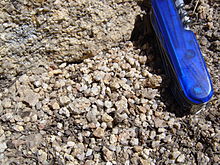
Framework grains are sand-sized (00.625-to-2 mm (24,606-to-0,079 in) diameter) detrital fragments that make up the bulk of a sandstone.[17][18] Most framework grains are composed of quartz or feldspar, which are the common minerals most resistant minerals to weathering processes at the Earth's surface, as seen in the Goldich dissolution series.[19] Framework grains can be classified into several different categories based on their mineral composition:
- Quartz framework grains are the dominant minerals in most clastic sedimentary rocks; this is because they have exceptional physical properties, such as hardness and chemical stability.[2] These physical properties allow the quartz grains to survive multiple recycling events, while also allowing the grains to display some degree of rounding.[2] Quartz grains evolve from plutonic rock, which are felsic in origin and also from older sandstones that have been recycled.
- Feldspathic framework grains are commonly the second most abundant mineral in sandstones.[2] Feldspar can be divided into alkali feldspars and plagioclase feldspars, which can be distinguished under a petrographic microscope.[2]
- Alkali feldspar range in chemical composition from KAlSi3O8 to NaAlSi3O8.[2]
- Plagioclase feldspar range in composition from NaAlSi3O8 to CaAl2Si2O8.[2]

- Lithic framework grains (also called lithic fragments or lithic clasts) are pieces of ancient source rock that have yet to weather away to individual mineral grains.[2] Lithic fragments can be any fine-grained or coarse-grained igneous, metamorphic, or sedimentary rock,[2] although the most common lithic fragments found in sedimentary rocks are clasts of volcanic rocks.[2]
- Accessory minerals are all other mineral grains in a sandstone. These minerals usually make up just a small percentage of the grains in a sandstone. Common accessory minerals include micas (muscovite and biotite), olivine, pyroxene, and corundum.[2][20] Many of these accessory grains are more dense than the silicates that make up the bulk of the rock. These heavy minerals are commonly resistant to weathering and can be used as an indicator of sandstone maturity through the ZTR index.[21] Common heavy minerals include zircon, tourmaline, rutile (hence ZTR), garnet, magnetite, or other dense, resistant minerals derived from the source rock.
Матрица
Matrix is very fine material, which is present within interstitial pore space between the framework grains.[2] The nature of the matrix within the interstitial pore space results in a twofold classification:
- Arenites are texturally clean sandstones that are free of or have very little matrix.[20]
- Wackes are texturally dirty sandstones that have a significant amount of matrix.[18]
Цемент
Cement is what binds the siliciclastic framework grains together. Cement is a secondary mineral that forms after deposition and during burial of the sandstone.[2] These cementing materials may be either silicate minerals or non-silicate minerals, such as calcite.[2]
- Silica cement can consist of either quartz or opal minerals. Quartz is the most common silicate mineral that acts as cement. In sandstone where there is silica cement present, the quartz grains are attached to cement, which creates a rim around the quartz grain called overgrowth. The overgrowth retains the same crystallographic continuity of quartz framework grain that is being cemented. Opal cement is found in sandstones that are rich in volcanogenic materials, and very rarely is in other sandstones.[2]
- Calcite cement is the most common carbonate cement. Calcite cement is an assortment of smaller calcite crystals. The cement adheres to the framework grains, cementing the framework grains together.[2]
- Other minerals that act as cements include: hematite, limonite, feldspars, anhydrite, gypsum, barite, clay minerals, and zeolite minerals.[2]
Sandstone that becomes depleted of its cement binder through weathering gradually becomes friable and unstable. This process can be somewhat reversed by the application of tetraethyl orthosilicate (Si(OC2H5)4) which will deposit amorphous silicon dioxide between the sand grains.[22] The reaction is as follows.
- Si(OC2H5)4 (l) + 2 H2O (l) → SiO2 (s) + 4 C2H5OH (g)
Слике
-
Пешчар са пругама од оксида гвожђа -
Обрађен узорак пешчара -
Опатија Арбро, пример обојености пешчара -
Arches National Park – пешчарски крајолик -
Стена Парус у Русији. -
Стенска формација пешчара у Израелу -
Савремена вила са фасадом од пешчара -
фосилне шкољке у пешчару -
Црвени пешчар у Доњем Антелоп Кањону, Аризона -
Пешчар са великом количином кварца -
Црвени пешчар пермске старости, Стара планина
Види још
Референце
- ^ Геолошка терминологија и номенклатура IV петрологија, Београд, 1975
- ^ а б в г д ђ е ж з и ј к л љ м н њ Boggs, Sam (2006). Principles of sedimentology and stratigraphy (4th изд.). Upper Saddle River, N.J.: Pearson Prentice Hall. стр. 119—135. ISBN 0131547283.
- ^ Swanson, Susan K.; Bahr, Jean M.; Bradbury, Kenneth R.; Anderson, Kristin M. (фебруар 2006). „Evidence for preferential flow through sandstone aquifers in Southern Wisconsin”. Sedimentary Geology. 184 (3–4): 331—342. Bibcode:2006SedG..184..331S. doi:10.1016/j.sedgeo.2005.11.008.
- ^ Bjørlykke, Knut; Jahren, Jens (2010). „Sandstones and Sandstone Reservoirs”. Petroleum Geoscience: 113—140. ISBN 978-3-642-02331-6. doi:10.1007/978-3-642-02332-3_4.
- ^ Marshak, Stephen. Essentials of Geology (3rd изд.). стр. 182.
- ^ Powell, Darryl. „Quartzite”. Mineral Information Institute. Архивирано из оригинала 2009-03-02. г. Приступљено 2009-09-09.
- ^ "A Basic Sedimentary Rock Classification", L.S. Fichter, Department of Geology/Environmental Science, James Madison University (JMU), Harrisonburg, Virginia, October 2000, JMU-sed-classif (accessed: March 2009): separates clastic, chemical & biochemical (organic).
- ^ Leeder, M. R. (2011). Sedimentology and sedimentary basins : from turbulence to tectonics (2nd изд.). Chichester, West Sussex, UK: Wiley-Blackwell. стр. 3—28. ISBN 9781405177832.
- ^ Blatt, Harvey; Tracy, Robert J. (1996). Petrology : igneous, sedimentary, and metamorphic. (2nd изд.). New York: W.H. Freeman. стр. 241—242, 258—260. ISBN 0716724383.
- ^ Blatt and Tracy 1996, pp. 220-227
- ^ Blatt and Tracy 1996, pp. 265-280
- ^ а б в г д Boggs 2006, pp. 147-154
- ^ а б Choquette, P.W.; Pray, L.C. (1970). „Geologic Nomenclature and Classification of Porosity in Sedimentary Carbonates”. AAPG Bulletin. 54. doi:10.1306/5D25C98B-16C1-11D7-8645000102C1865D.
- ^ Walker, Theodore R.; Waugh, Brian; Grone, Anthony J. (1. 1. 1978). „Diagenesis in first-cycle desert alluvium of Cenozoic age, southwestern United States and northwestern Mexico”. GSA Bulletin. 89 (1): 19—32. Bibcode:1978GSAB...89...19W. doi:10.1130/0016-7606(1978)89<19:DIFDAO>2.0.CO;2.
- ^ Boggs 2006, p. 148
- ^ Stone, W. Naylor; Siever, Naylor (1996). „Quantifying compaction, pressure solution and quartz cementation in moderately-and deeply-buried quartzose sandstones from the Greater Green River Basin, Wyoming”. Приступљено 2. 10. 2020.
- ^ Dorrik A. V. Stow (2005). Sedimentary Rocks in the Field: A Colour Guide. Manson Publishing. ISBN 978-1-874545-69-9. Приступљено 11. 5. 2012.
- ^ а б Francis John Pettijohn; Paul Edwin Potter; Raymond Siever (1987). Sand and Sandstone. Springer. ISBN 978-0-387-96350-1. Приступљено 11. 5. 2012.
- ^ Prothero & Schwab, Donald R. & Fred (1996). Sedimentary Geology. W. H. Freeman. стр. 24. ISBN 0-7167-2726-9.
- ^ а б Prothero, D. (2004). Sedimentary Geology. New York, NN: W.H. Freeman and Company
- ^ Prothero, D. R. and Schwab, F., 1996, Sedimentary Geology, p. 460, ISBN 0-7167-2726-9
- ^ Zárraga, Ramón; Alvarez-Gasca, Dolores E.; Cervantes, Jorge (1. 9. 2002). „Solvent effect on TEOS film formation in the sandstone consolidation process”. Silicon Chemistry. 1 (5): 397—402. S2CID 93736643. doi:10.1023/B:SILC.0000025602.64965.e7.
Литература
- Ђорђевић В., Ђорђевић П., Миловановић Д. 1991. Основи петрологије. Београд: Наука
- Folk, R.L., 1965, Petrology of sedimentary rocks PDF version. Austin: Hemphill's Bookstore. 2nd ed. 1981, ISBN 0-914696-14-9.
- Pettijohn F. J., P.E. Potter and R. Siever, 1987, Sand and sandstone, 2nd ed. Springer-Verlag. ISBN 0-387-96350-2.
- Scholle, P.A., 1978, A Color illustrated guide to constituents, textures, cements, and porosities of sandstones and associated rocks, American Association of Petroleum Geologists Memoir no. 28. ISBN 0-89181-304-7.
- Scholle, P.A., and D. Spearing, 1982, Sandstone depositional environments: clastic terrigenous sediments , American Association of Petroleum Geologists Memoir no. 31. ISBN 0-89181-307-1.
- USGS Minerals Yearbook: Stone, Dimension, Thomas P. Dolley, U.S. Dept. of the Interior, 2005 (format: PDF).
- Webb, Jonathan. Sandstone shapes 'forged by gravity' (July 2014), BBC
- Jackson, J. (1997). Glossary of Geology. Alexandria, VA: American Geological Institute ISBN 3-540-27951-2

